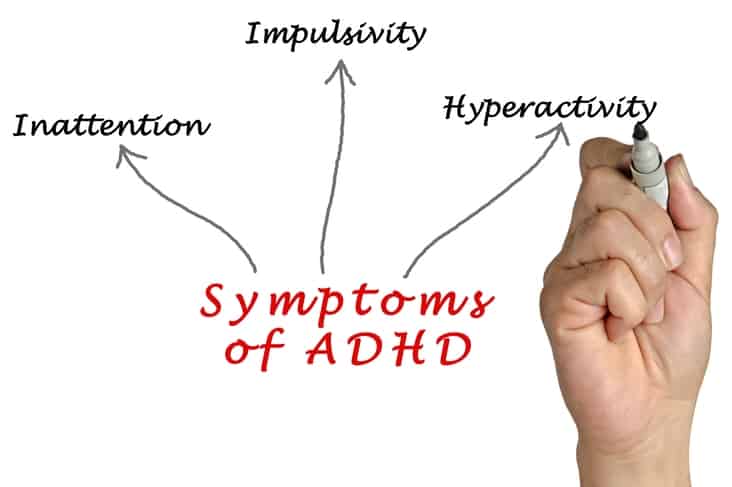ADHD types (presentations) and behavioural problems. Introduction

The core symptoms of ADHD – inattention, hyperactivity, and impulsivity – rarely occur alone. Often, affected children and adolescents with ADHD have other problems that can change as they age.
Although most children and adolescents with ADHD do not differ in their intellectual abilities from others, many struggle with academic performance problems. They have difficulties in reading, spelling, or arithmetic and, as a result, often repeat a grade.
The symptoms vary in different individuals with two predominant ADHD presentations: inattentive and hyperactive-impulsive as well as the mixture of both: combined presentation.
Children with ADHD often do not respond to normal disciplinary measures in the same way as other children. Consequently, parents, caregivers, and teachers often find themselves in challenging situations. Positive experiences become overshadowed by these negative events, both within the family and in kindergarten or school.
ADHD diagnosis and its subtypes (presentations)
The diagnosis of attention disorders is based on WHO’s internationally defined criteria set forth in the ICD 10 (International Classification of Diseases) and the DSM-5 classification system (Diagnostic and Statistical Manual of Mental Disorders), developed by the American Psychiatric Association. You will find the criteria in our other article about diagnosing ADHD.
As with all mental disorders, nowadays the term “illness” is avoided when referring to ADHD to emphasize the distinction from physical diseases. Therefore, the more neutral term “mental disorder” is preferred internationally.
The characteristics of attention deficit disorder, hyperactivity, and impulsivity may not be equally present in all cases. Therefore, DSM 5 differentiate further ADHD in subtypes distinguishing between inattentive, hyperactive-impulsive and combined presentations.
In cases of lower severity, not all three areas are equally apparent, and the problems may not occur to the same extent in all aspects of their lives. It is also possible for ADHD to manifest in different forms as a child develops:
In the preschool years, symptoms of hyperactivity and impulsivity often dominate, while in later development, especially during adolescence, inattention takes the forefront and hyperactivity diminishes.
In the American classification system (DSM-5), the following three presentations (subtypes) of ADHD are distinguished from one another.
Predominantly inattentive ADHD presentation
In ADHD with predominantly inattentive presentation, individuals often fail to give close attention to details or make careless mistakes. They struggle to sustain attention, do not appear to listen, and have difficulty following instructions. Additionally, they face challenges with organization, avoid or dislike tasks requiring sustained mental effort, and tend to lose things easily. Moreover, they are easily distracted and forgetful in daily activities.
ADHD with predominantly hyperactive-impulsive presentation
ADHD individuals with hyperactive-impulsive presentation, frequently fidget with hands or feet, squirm in chairs, and have difficulty remaining seated. They engage in excessive running or climbing, which manifests as extreme restlessness in adults. Moreover, they struggle to engage in activities quietly and act as if automatically driven. Adults with this presentation often feel internally “driven by a motor”. They also tend to talk excessively, blurt out answers, and have difficulty waiting or taking turns. Additionally, they may interrupt or intrude upon others.
ADHD with Combined presentation
The Combined presentation involves meeting the criteria for both inattention and hyperactive-impulsive presentations.
Children and adolescents with this form of ADHD exhibit characteristics in all three areas, including pronounced hyperactivity, strong impulsivity, and marked inattention. To receive a diagnosis, these symptoms must start before age 12, be present in multiple settings, and interfere with functioning at home, school or work, and social settings. Moreover, they cannot be better explained by another disorder.
ADHD in partial remission
If symptoms decrease in adolescence or adulthood to the point where they are no longer sufficiently present for a diagnosis, according to DSM-5, it is possible to add the term “in partial remission” for adolescents and adults.
Residual type of ADHD
In the residual type of ADHD, not all symptoms that were present during childhood, are fully expressed but they still persist. However, in adolescence, hyperactivity and partly impulsivity often decrease, while attention deficits (inattention) remain.
Additional problems in ADHD
The core symptoms of ADHD – inattention, hyperactivity, and impulsivity – rarely occur alone. Often, affected children and adolescents with ADHD have other problems that can change as they age. Unpleasant experiences and negative interactions occur more frequently between parents, teachers and the child or adolescent.
Most commonly, children and adolescents with ADHD also exhibit oppositional and aggressive behaviours.
Conflicts with parents, teachers and peers
A variety of children and adolescents with ADHD are often rejected by their peers. This can happen because they constantly disrupt play due to their ADHD symptoms or because their aggressive behaviours are perceived as bullying.
Due to the frequently socially inappropriate behaviours of children and adolescents with ADHD, parents often have increased conflicts with their child, and the relationships between parents and child are often highly strained.
Oppositional and aggressive behaviour
Most commonly, children and adolescents with ADHD also exhibit oppositional and aggressive behaviours. These behaviours include not following important rules in the family, kindergarten, and school. Additionally, they do not respond to instructions from adults, often have outbursts of anger, and engage in frequent conflicts with siblings and other children.
In adolescence, it can occur that individuals with ADHD disregard important social rules. This can lead to various behaviours: some lie to gain advantages, some steal within or outside the family, or they skip school and stay out later at night than allowed. As a result of theft or property damage, individuals with ADHD often eventually come into conflict with the law.
Tics
Motor tics are sudden, involuntary movements such as eye blinking, nose twitching, or jerking of the head. Vocal tics are involuntary vocalizations, such as throat clearing, or even words and phrases that are suddenly spoken out. Such tics occur more frequently in children with ADHD, often starting in childhood and persisting into adolescence and adulthood.
Conclusion. ADHD presentations, behavioural problems and their consequences
The symptoms of ADHD vary not only in different individuals but also across their development. While during the preschool years, symptoms of hyperactivity and impulsivity are more often, they can change in later development, especially during adolescence, with the inattention in the forefront.
The classification system of American Psychiatric Association, DSM 5 differentiates ADHD in three subtypes: inattentive, hyperactive-impulsive and combined presentation.
Due to their restlessness, impulsive behaviour, children with ADHD often exceed boundaries more frequently compared to other children. This creates a vicious cycle of admonishments and boundary setting. Positive experiences become overshadowed by these negative events affecting the interaction within family, scholl and in later age in professional and social circle.
These negative experiences increase the risk of the child or adolescent responding with even greater restlessness, impulsivity, and inattention, as well as an increase in oppositional behaviour. As a result, the symptoms of ADHD and additional problems such as anxiety, depression but also aggressive and defiant behaviour continue to escalate.

DR. GREGOR KOWAL
Senior Consultant in Psychiatry,
Psychotherapy And Family Medicine
(German Board)
Call +971 4 457 4240
